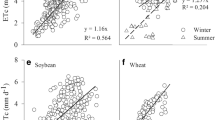Abstract
‘Russet Burbank’ potatoes (Solarium tuberosum L.) were subjected to various levels of water application during the growing season. Water applied, rainfall, and soil water changes were measured at weekly intervals. Tuber yield and quality increased as water consumption increased from 300 mm to 650 mm. Evapotranspiration (ET) increased rapidly from plant emergence until early tuber bulking and declined gradually as plants matured. Comparing ET with pan evaporation provided coefficients (K) which changed in response to crop growth stages. K increased from 0.3 at emergence to over 0.8 during maximum leaf area and declined with crop maturity. The relationship between K and crop growth stage can be used with confidence in scheduling irrigation of potatoes in north central Oregon.
Resumen
Papas (Solarium tuberosum L.) de la variedad “Russet Burbank” fueron sometidas a varios niveles de aplicación de agua durante la temporada de cultivo. La cantidad de agua aplicada, la lluvia y el contenido de agua del suelo fueron medidos a intervalos semanales. El rendimiento y la calidad de los tubérculos incrementó a medida que el consumo de agua aumentó de 300 mm a 650 mm. La evapotranspiración (ET) aumentó rápidamente desde la emergencia hasta el “llenado” temprano do los tubérculos y declinó gradualmente a medida que maduraban las plantas. Comparaciones de ET con valores del tanque de corporación suministraron coeficientes (K) que variaron de acuerdo a las fases de crecimiento de cultivo. K aumentó de 0.3 en la emergencia a más de 0.8 al momento de máxima área foliar y declinó con la madurez del cultivo. La relación entre K y la etapa de desarrollo del cultivo puede ser usado con confianza al programar la irrigación de la papa en el norte y centro de Oregon.
Similar content being viewed by others
Literature Cited
Doorenbos, J. and A.H. Kassam. 1979. Yield response to water, FAO Irrigation and Drainage Paper 33. Rome. pp. 121–124.
Dubetz, S. and K.K. Krogman. 1973. Comparison of methods of scheduling irrigation of potatoes. Am Potato J 50:408–414.
Gear, R.D., A.S. Dransfield and M.D. Campbell. 1977. Irrigation scheduling with neutron probe. J. Irrigation Drainage Div., ASCE 103:291–298.
Hanks, R.J., J. Keller, V.P. Rasmussen and G.D. Wilson. 1976. Line source sprinkler for continuous variable irrigation—crop production studies. Soil Sci Soc Am J 40:426–429.
Jensen, M.E. and H.R. Haise. 1963. Estimating evapotranspiration from solar radiation. J. Irrigation Drainage Div., ASCE 89:15–41.
Jensen, M.C. and J.E. Middleton. 1970. Scheduling irrigation from pan evaporation. Washington Agric Exp Stn Circular 527, p. 12.
Loon, C.D. van. 1981. The effect of water stress on potato growth, development, and yield. Am Potato J 58:51–69.
Martin, M.W. and D.E. Miller. 1980. Differential reaction of potato cultivars to deficit irrigation. Am Potato J 57:488.
Nelson, S.H. and K.E. Hwang. 1975. Water usage by potato plants at different stages of growth. Am Potato J 52:331–339.
Penman, J.L. 1963. Vegetation and hydrology. Commonwealth Bureau of Soils, Harpenden, England. Tech. Comm. No. 53, pp. 1–125.
Salter, P.J. and J.E. Goode. 1967. Crop response to water at different stages of growth. Commonwealth Agricultural Bureau, Farnham Royal, Bucks, England. Research Review 2, pp. 93–99.
Singh, Gurbachan. 1969. A review of the soil-moisture relationship in potatoes. Am Potato J 46:398–403.
Stegman, E.C., A. Bauer, J.C. Zubriski and J. Bauder. 1977. Crop curves for water balance irrigation scheduling in S.E. North Dakota. North Dakota Research Report No. 66.
Wilcox, D.A. and R.A. Ashley. 1982. The potential use of plant physiological response to water stress as an indication of varietal sensitivity to drought in four potato (Solarium tuberosum L.) varieties. Am Potato J 59:533–545.
Wright, J.L. 1982. New evapotranspiration crop coefficients. J Irrigation and Drainage Div., ASCE 108:57–74.
Wright, J.L. and M.E. Jensen, Agricultural Research Service-United States Department of Agriculture, Computerized Irrigation Scheduling Programs (Revisions), Technical Letter to Users of Irrigation Scheduling Program, USDA, ARS, Western Region, Snake River Conservation Research Center, Kimberly, Idaho. 1974.
-. 1978. Potatoes for processing and chipping. Inspection instructions. USDA Fruit and Veg. Quality Div., pp. 1–55.
Author information
Authors and Affiliations
Additional information
Technical Paper No. 7024, Oregon State University Agricultural Experiment Station.
Rights and permissions
About this article
Cite this article
Hane, D.C., Pumphrey, F.V. Yield-evapotranspiration relationships and seasonal crop coefficients for frequently irrigated potatoes. American Potato Journal 61, 661–668 (1984). https://doi.org/10.1007/BF02852929
Accepted:
Issue Date:
DOI: https://doi.org/10.1007/BF02852929




